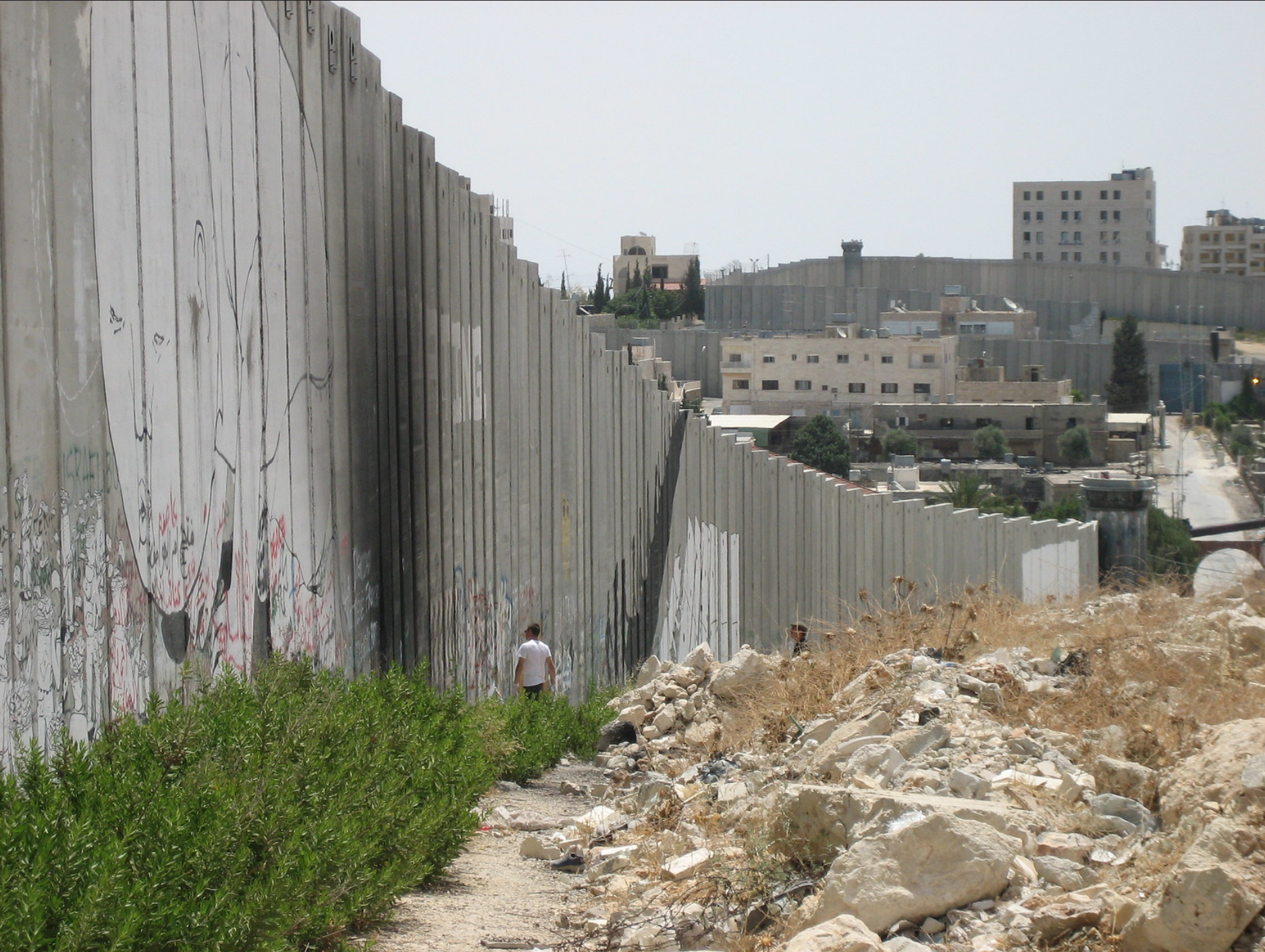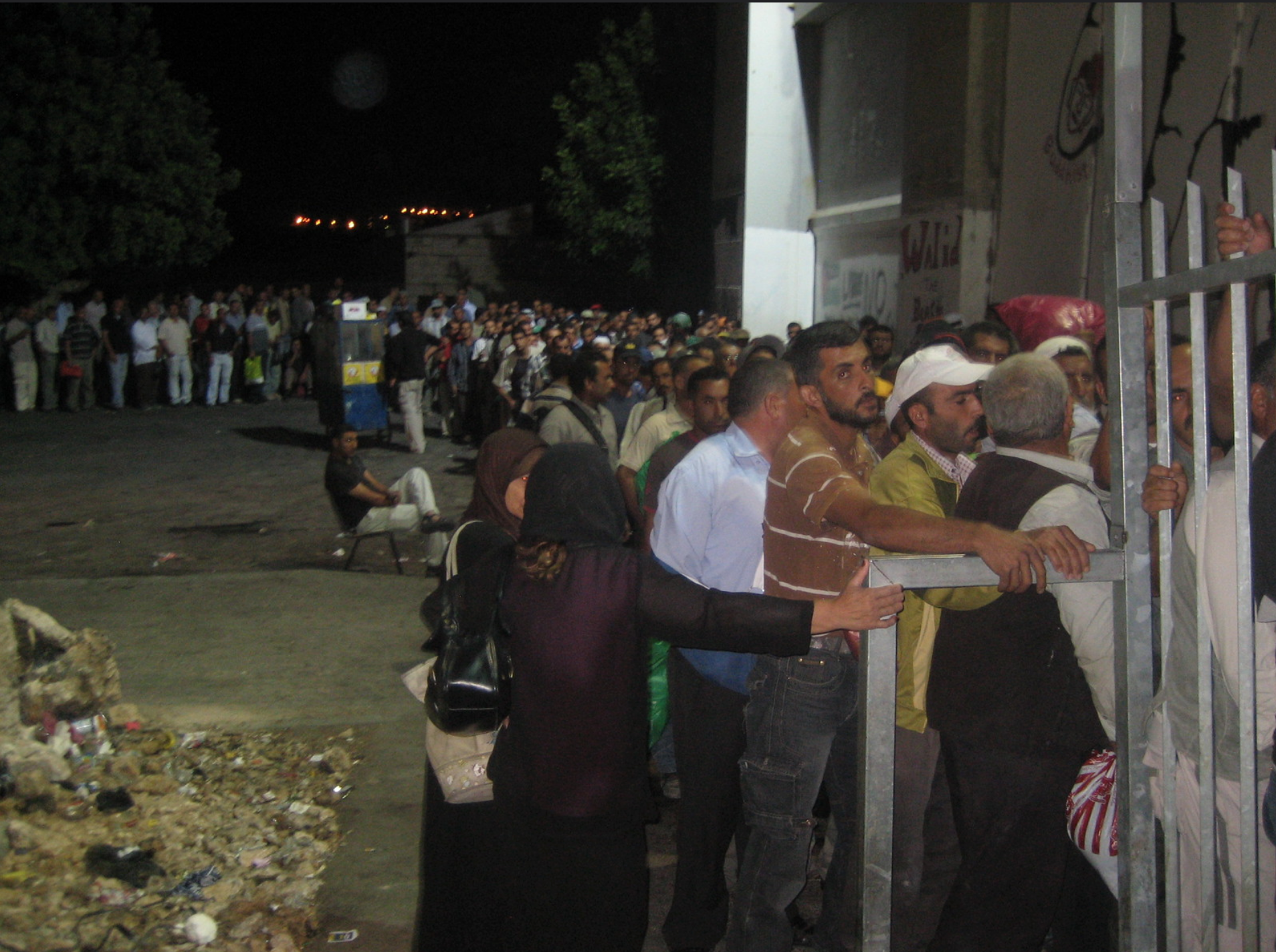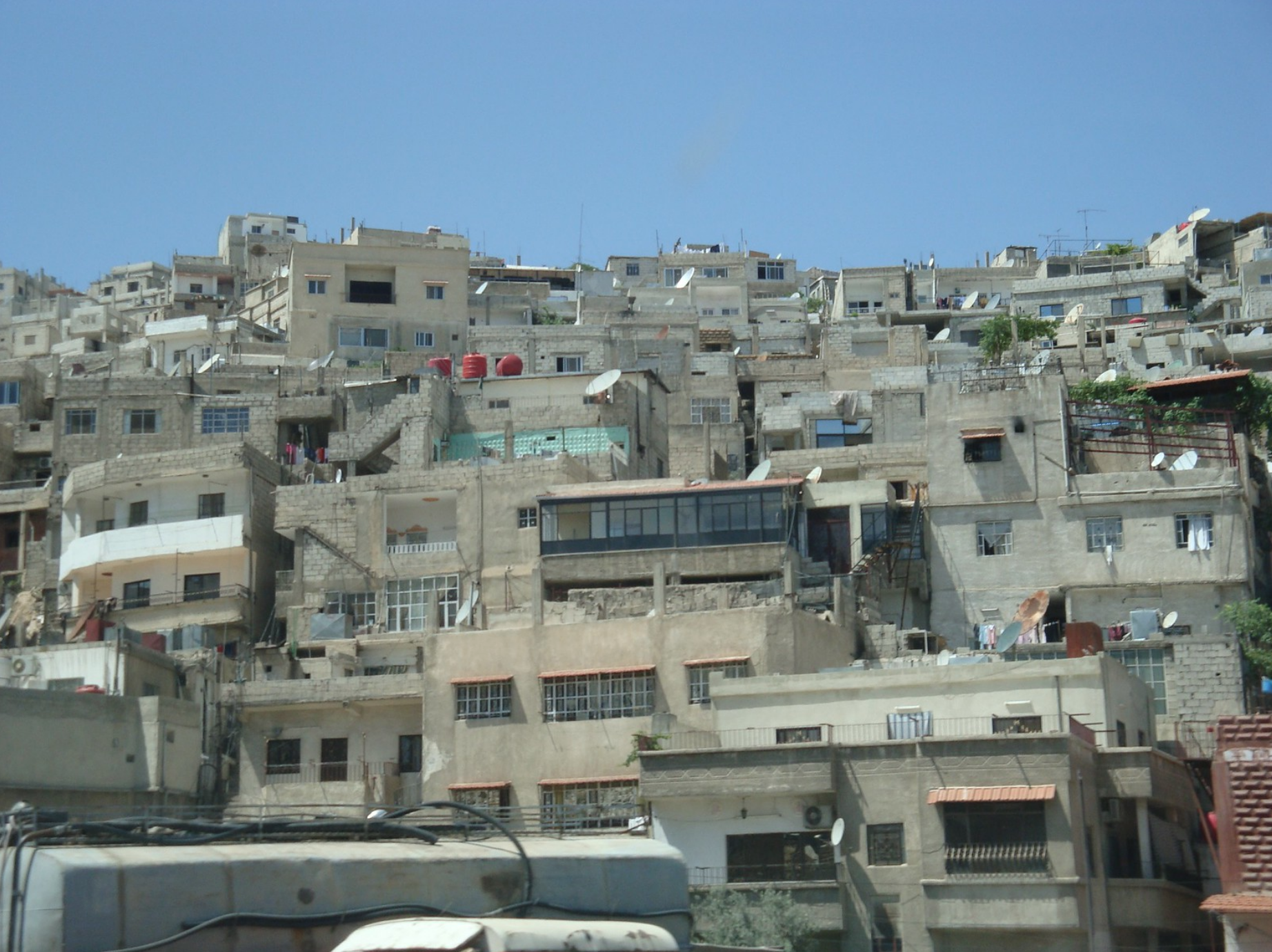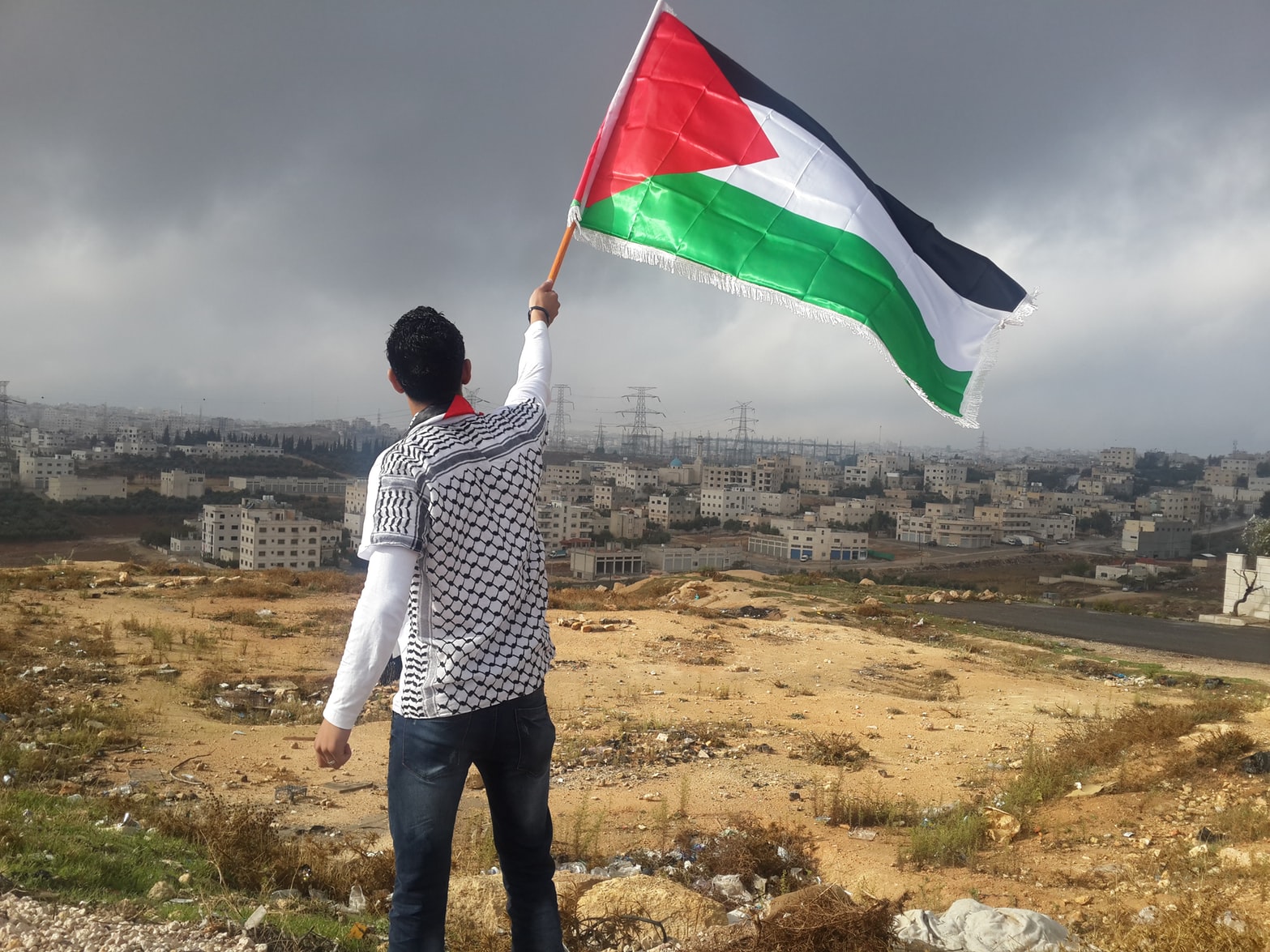
Featured Image: the wall between Israel and West Bank (Photo: Rianne Van Doevern).
By Yilin Chen
Stretching over seven hundred kilometers, the Israeli West Bank separation barrier sharply cuts through the local landscape. In some places, it is a thirty-foot concrete wall. Elsewhere, it is a series of electric and razor wire fences. Sprinkled along the barrier and within the West Bank area are ominous watchtowers, cement blocks, and armed soldiers. These are constant reminders of an Israeli military presence in the State of Palestine.
The most distinctive physical feature of the Palestinian experience occurs at borders, checkpoints, roadblocks—essentially any form of barrier that requires a scrutiny of identity. For Palestinians, what are routine activities for most citizens of the world become a daily nuisance that often entails humiliation and violence. Whether they are visiting relatives, seeking emergency healthcare, or simply driving to work, they are subjected to inhumane and often violent treatment. Occasionally, Israeli soldiers force them to take off their jackets, t-shirts, and even their pants to show they have nothing to hide. In a cruel metaphorical sense, this procedure reflects how frequently Palestinians are stripped of their dignity. Their individual identities are disregarded as Israeli soldiers treat them uniformly as security threats.

Apart from physical barriers, however, what constitutes the Palestinian experience? How has the Palestinian identity evolved historically? More importantly, in a region plagued by conflict, where civilians fight on the ground and politicians clash in legislative institutions, what invisible barriers do Palestinians face in the struggle to find a sense of belonging?
Lauren Banko is a lecturer in modern history of Arab Middle East at Yale. According to Banko, a Palestinian-Arab identity developed as a separate concept from other Arab nations during the British mandate period in Palestine (1923-1943). Palestinian people constructed a definition of themselves as a response “against Jewish immigration and Zionism” in order to actively protect their territory, she says. They also voiced a desire for self-determination, a crucial component of the political trend of nationalism after World War I.
Then came the 1948 Arab-Israeli War. For Israelis, the war was a triumph that created the State of Israel. For Palestinians, on the other hand, the war is referred to as nakba, or catastrophe, a throbbing wound in the national memory. Seven million Palestinians fled or were expelled from their homes, becoming refugees scattered across the Middle East. The residents of Mandatory Palestine who remained inside Israeli borders later became Arab citizens of Israel, often referred to as Arab Israelis. Arabs currently represent twenty-one percent of the Israeli population, according to a 2019 report from the Israel Central Bureau of Statistics.
At first glance, the distinction between the categories of Palestinians is simple. Palestinian citizens of Israel and East Jerusalem Palestinians have a blue ID card, while those in the occupied territories of the West Bank and the Gaza Strip hold green ones. In reality, the colors make a world of difference. Those colors directly translate to the amount of freedom and rights that the cardholders possess.
Palestinians living under Israeli occupation in East Jerusalem, Gaza, and the West Bank are effectively a stateless people who lack the rights of citizenship to any sovereign nation. Without the right to vote, they cannot elect the Israeli officials who have direct control over the occupied territories. They lack the right to due process under the law and civil rights granted to Israeli citizens, often subjecting them to longer trials, prolonged or indefinite “administrative detention,” and even torture. In every aspect of their lives, including needs as fundamental as food and healthcare, residents of the occupied territories have only the bare minimum of freedom. It is almost impossible for Palestinians in the occupied territories to gain Israeli citizenship.
Even for those Palestinians who do become Israeli citizens, they face both de jure and de facto discrimination based on their Arab identity. Central to this problem is the Israeli dual construct of citizenship and nationality, unlike most other countries where the two terms are more or less interchangeable. In March 2019, Israeli Prime Minister Benjamin Netanyahu posted online that “Israel is not a state of all its citizens. According to the basic nationality law we passed, Israel is the nation-state of the Jewish people—and only it.” He referred to a deeply contentious law passed in July 2018 that upheld the status of Jews while relegating Arabic from an official language to one with “special status.” The outraged Arab community has denounced the law as racist and undemocratic and has likened it to the Apartheid.
Professor Banko explains that nationality in Israel is deeply linked with religion. The Israeli citizenship does not give Arabs the same rights as Jews. As non-Jews, they face institutionalized racism cleverly concealed beneath the appearance of equal rights and humanitarianism. For example, according to The Middle East Policy Council, Arab Israeli citizens don’t have access to the land owned by the Jewish Agency, a national institution with vast resources. It controls ninety-two percent of the land of Israel, much of which has been taken from the Arabs. Non-Jews can neither own the land nor work on it.
For Palestinian refugees scattered in the surrounding areas, the vague and varying definitions of their legal status entail equally disturbing consequences. In a presentation at the Yale MacMillan Center, Professor Michael Vicente Pérez from the University of Memphis detailed the invisible barriers around the Gazan refugee experience in Jordan, despite their access to legal residence and humanitarian aid. When Gazans were displaced by the 1967 Arab-Israeli war, Jordan allowed their entry through the category of foreign citizens. “Their status denies the fact that Gazans came to Jordan as an already displaced community of stateless refugees, not citizens.” Pérez says, “[It also] subjected them to a host of restrictions that precluded their access to some of the most basic needs . . . including prohibitions on work, education, healthcare, property, voting rights, etc.” Without citizenship, these refugees must perpetually grapple with a sense of uncertainty about their future prospects. They live on the margins as a people unmoored.

To remain stateless or to accept the citizenship of another country? Palestinians are internally divided on this issue. Professor Banko explains, “the idea after 1948 is that to grant the Palestinian refugees citizenship of another state would take away their right to someday claim Palestinian citizenship in a future Palestinian state.” Echoing this sentiment, many Palestinians in exile choose to endure the pervasive limitations that come with statelessness.
Meanwhile on the other end of the spectrum, there are Arab Israelis who are satisfied with their citizenship status and even choose to become Israeli soldiers. Although the mandatory conscription of the Israeli Defense Forces (IDF) does not apply to Muslim, Christian, and Bedouin Arabs, more and more Arab Israelis are volunteering to serve in the army. Now, the number of Arab Israelis serving in the IDF has reached several hundred.
In an interview with BBC news, Muslim Arab soldier Mahmud Kashua says, “I consider myself an Arab and a Muslim but I also consider myself part of [Israel].” By serving in the Israeli army, Arabs like Kashua are defying their ethnic tradition. Within the Palestinian community, this decision is synonymous with joining an oppressive regime, betraying one’s own people, and indoctrinating the youth with more anti-Palestinian sentiment.
Even though the Palestinian identity partly emerged as a response against the Jewish and Zionist identity, framing the two sides as sharply antithetical overlooks the fundamental similarities in the people. Beneath the violence and chaos emblazoned across newspaper front pages stirs rising activism at the Israeli and Palestinian grassroots level aimed at promoting mutual understanding.
Founded in 1995, the Parents Circle – Families Forum (PCFF) is a joint Israeli-Palestinian organization of over 600 families who have lost loved ones to the conflict. Its Parallel Narrative Project gathers participants from both sides to share personal narratives. The conversations transcend the barrier between the two sides and gives a voice to the suppressed Palestinian experience. Alon Simon, an Israeli living in Tel Aviv, describes his loss of words upon hearing the obstacles that Palestinians encounter at the borders. “What could I say?” he writes, “I am on the stronger side, free to go where I choose, and have never been humiliated or abused by the authorities.”
It is also worth noting that many initiatives for bilateral empathy have recognized the importance of integrating the youth. For example, the PCFF’s Peace & Reconciliation Camp brings together forty Israeli and Palestinian teens for five days of shared experience each year since 2003. Through activities, workshops, and casual conversation, the camp aims to dispel stereotypes of the “other” and promote leaders of the next generation. The camp counselors are alumni of the program, no more than young adults themselves, who choose to continue the mission of educating the youth.
Efforts like these embrace dialogue as an alternative to violence. It brings both sides together to acknowledge the individual, human stories that are overshadowed by national struggles. Whether one is Israeli or Palestinian, Jewish or Muslim, a speaker of Hebrew or a speaker of Arabic, these stories show that the two groups of people possess a multitude of experience that defy generic labeling. Israelis begin to understand the grievances of the Palestinians, and in turn, Palestinians recognize that many Israelis strongly desire peace as much as they do.

The younger generation plays an increasingly active role in amplifying the voices of the Palestinian experience. Francesca Maviglia (Yale School of Public Health ’20), Mojique Tyler (Yale College ’20), and Alysha Siddiqi (Yale College ’23) are members of the Students for Justice in Palestine (SJP) at Yale. They particularly emphasize the ways that the Palestinian struggle relates to other movements. Maviglia says, “we want to highlight issues like the training of U.S. police in Israel, the U.S. military support of Israel, and how Israel’s security technology is also used at the U.S. Mexico border to control the flow of migrants. We try to bring attention to the way that Palestine is relevant everywhere and for everyone. It shouldn’t be an issue that only concerns a faraway people.” They point out that the Palestinian struggle can be considered in conjunction with indigenous people under occupation, African-American people dealing with police brutality, and workers advocating for labor rights. It’s a struggle that transcends borders in its core pursuit of resistance, justice, and a sense of belonging.
Tyler stresses the importance of hearing directly from the Palestinian diaspora. He says, “we can make the occupation of Palestine part of the public sphere and something that people can’t look away from.” Drawing from her own experience of visiting Jerusalem and Palestine, Siddiqi echoes this sentiment by referencing disparities between media coverage and the reality in Palestine.
But Siddiqi also expresses her hope for the future: “I had the chance to visit Jerusalem and Palestine a few years ago. One thing that really stuck with me was the common characteristics that Palestinians shared: a strong national identity and [pride] despite the humanitarian crisis. Palestinians that I’ve met at Yale also hold a very strong love for their country. They strongly hope that one day activism and advocacy will end the occupation.”The everyday experience of Palestinians involves passing through obstacles and barriers, but that is by no means the whole picture. Compared to the physical discomfort and humiliation, the intangible limitations on their status pose a more severe problem that extends to the broader Palestinian diaspora. In addition to asking what the Palestinian identity means, it is crucial to consider what it lacks: the rights and privileges that are denied based on citizenship, or simply which side of the border one lives in. Despite the territorial and legislative disputes, however, grassroot dialogues and ongoing activism offer hope of chipping away at the wall—both literally and figuratively.
Yilin Chen is a first-year in Timothy Dwight College. She can be contacted at yilin.chen@yale.edu.